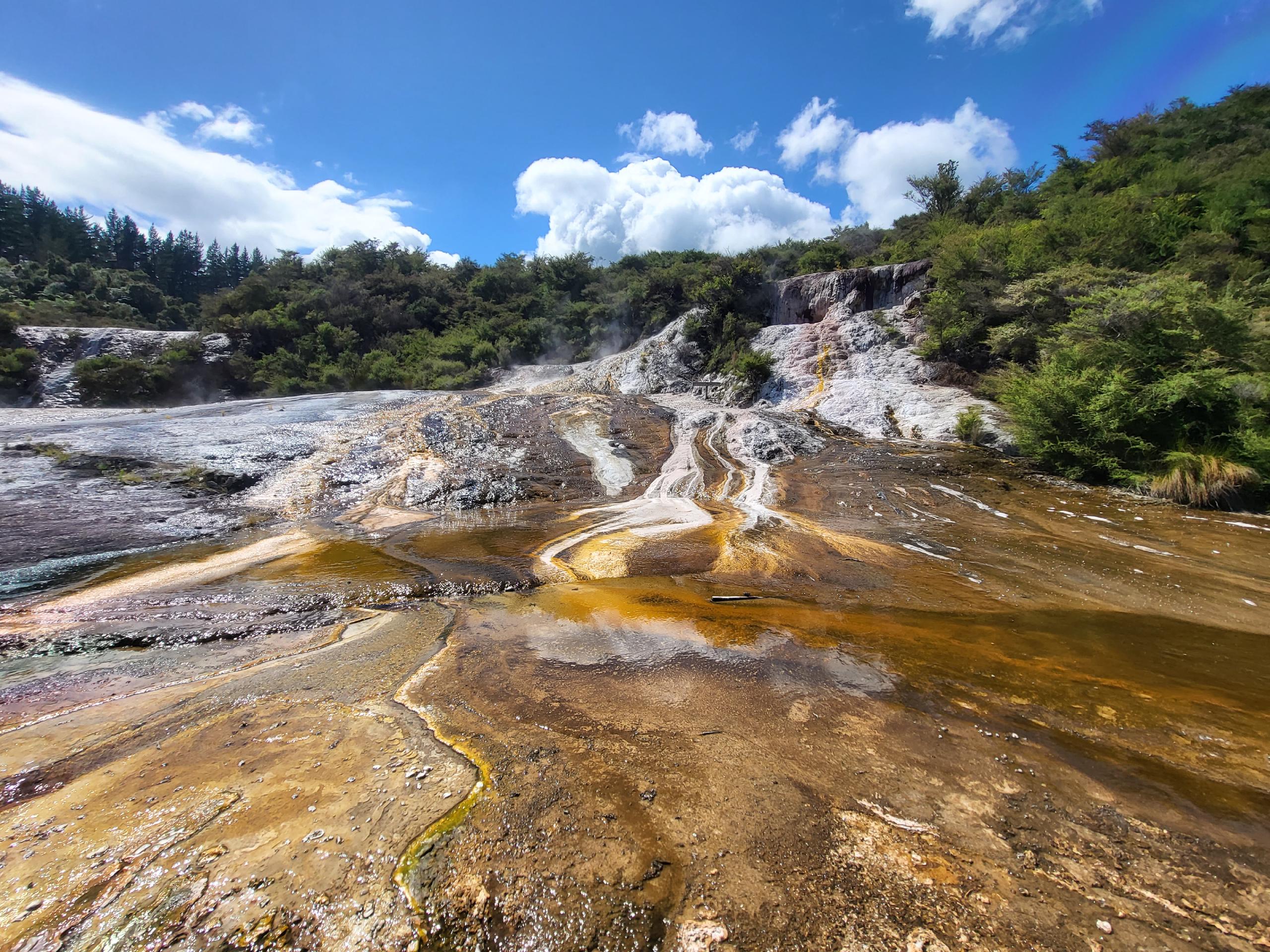Taupō Volcanic Zone (1/2)
December 30, 2023 • 10 minutes • 1948 words • Other languages: Deutsch
Today was the last day we would spend together with our parents before they would continue their round trip on their own and we would drive back to Auckland. Before leaving, they still had the opportunity to enjoy the view over Rotorua at least once.
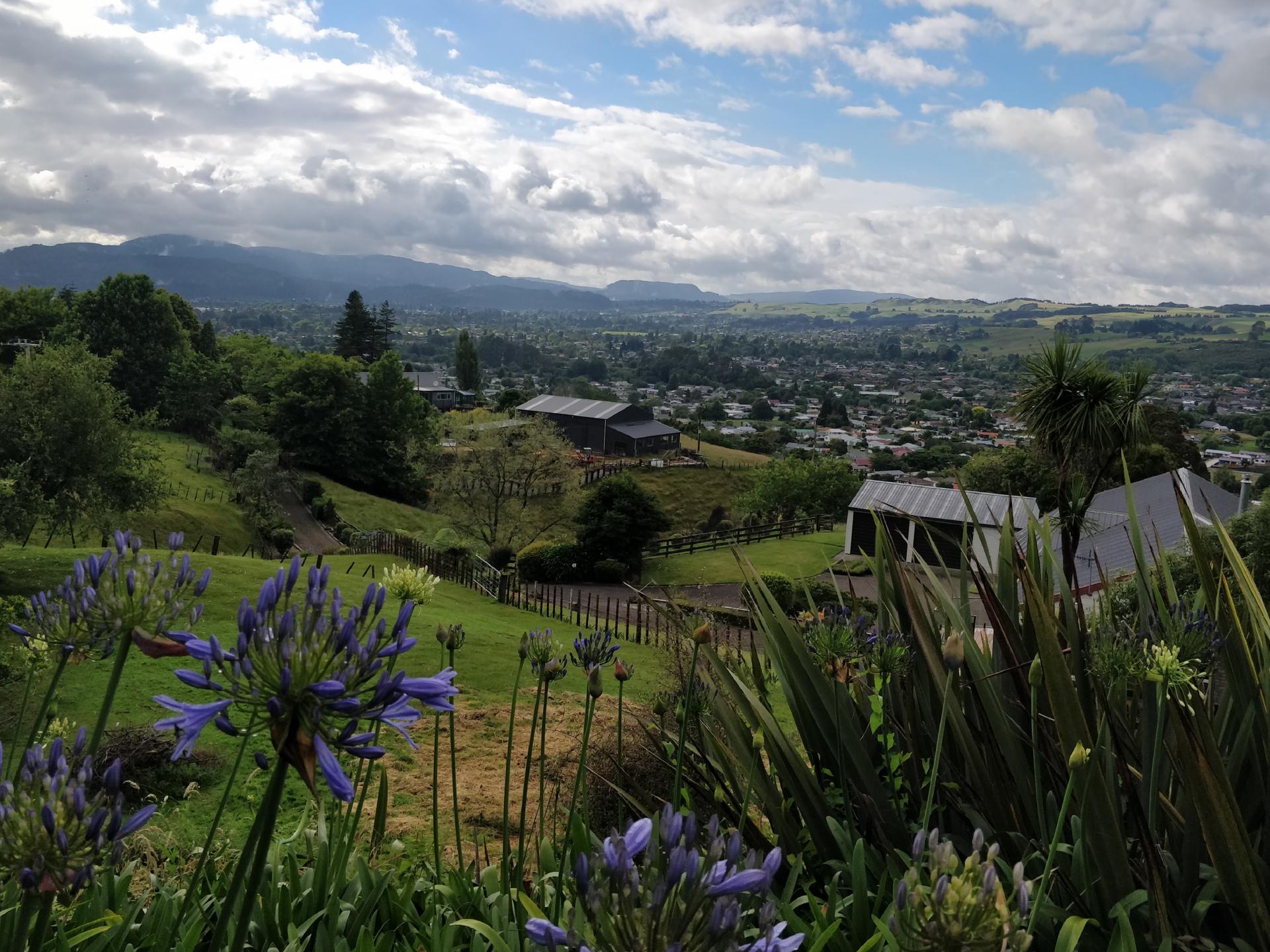
We met at the Government Gardens to continue south - this time with both cars again.
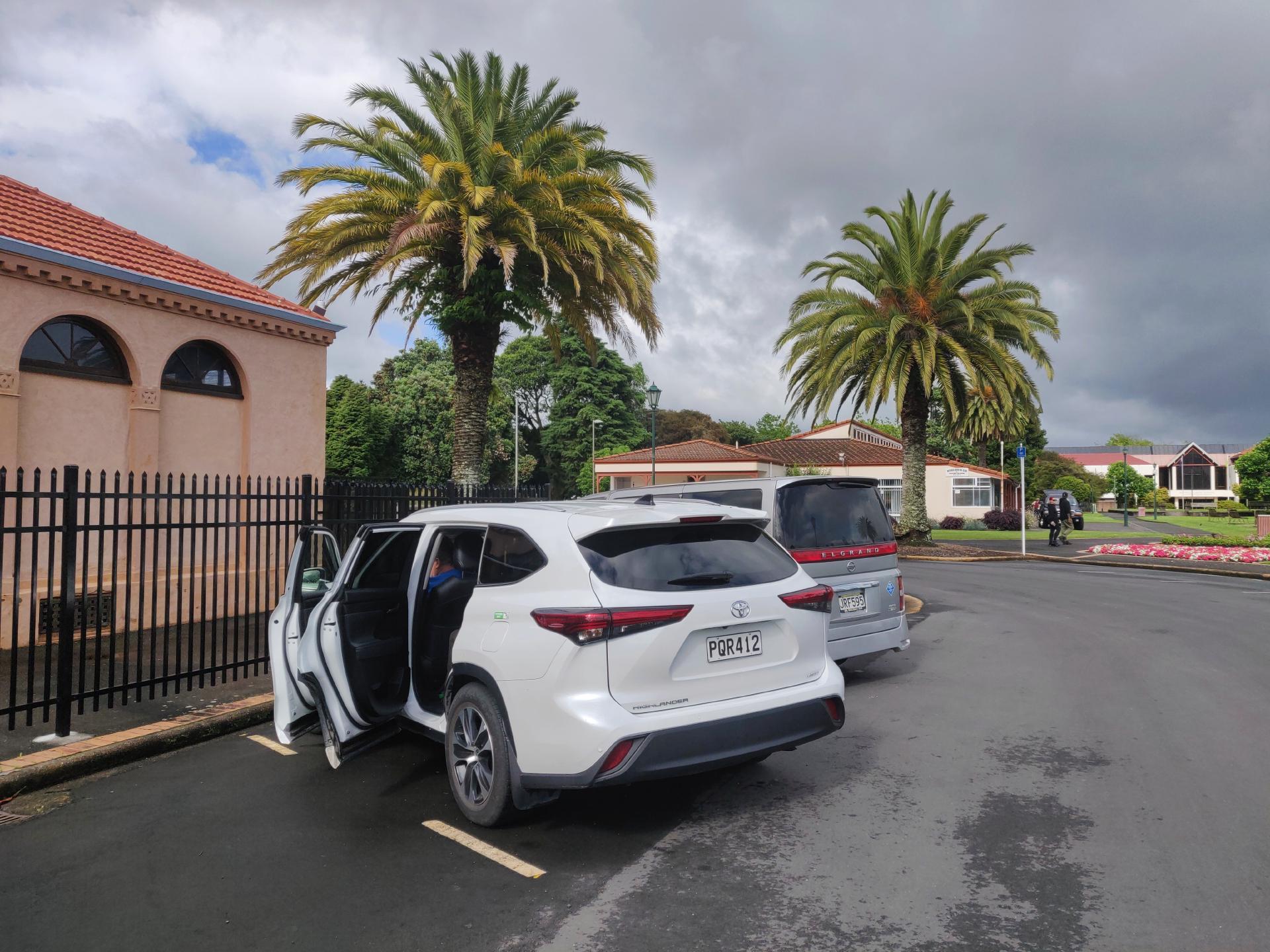
In the good weather, Rachel Spring looked more like a normal pond than a mystical, steaming hot spring.

About an hour’s drive later, we arrived at the parking lot of Orakei Korako. Today was probably the best weather we’ve ever had on a visit to a geothermal park. However, it was said to be 2-3°C warmer inside the park than outside, so we packed plenty of sunscreen and water.
Orakei Korako means “place of adornment”. The name was definitely justified, as we would later find out. We bought tickets and queued at the jetty, as the park itself was on the other side of a river, which we would cross on a small boat that went back and forth as needed.
As it was our last day together, the group selfies were of course a must.
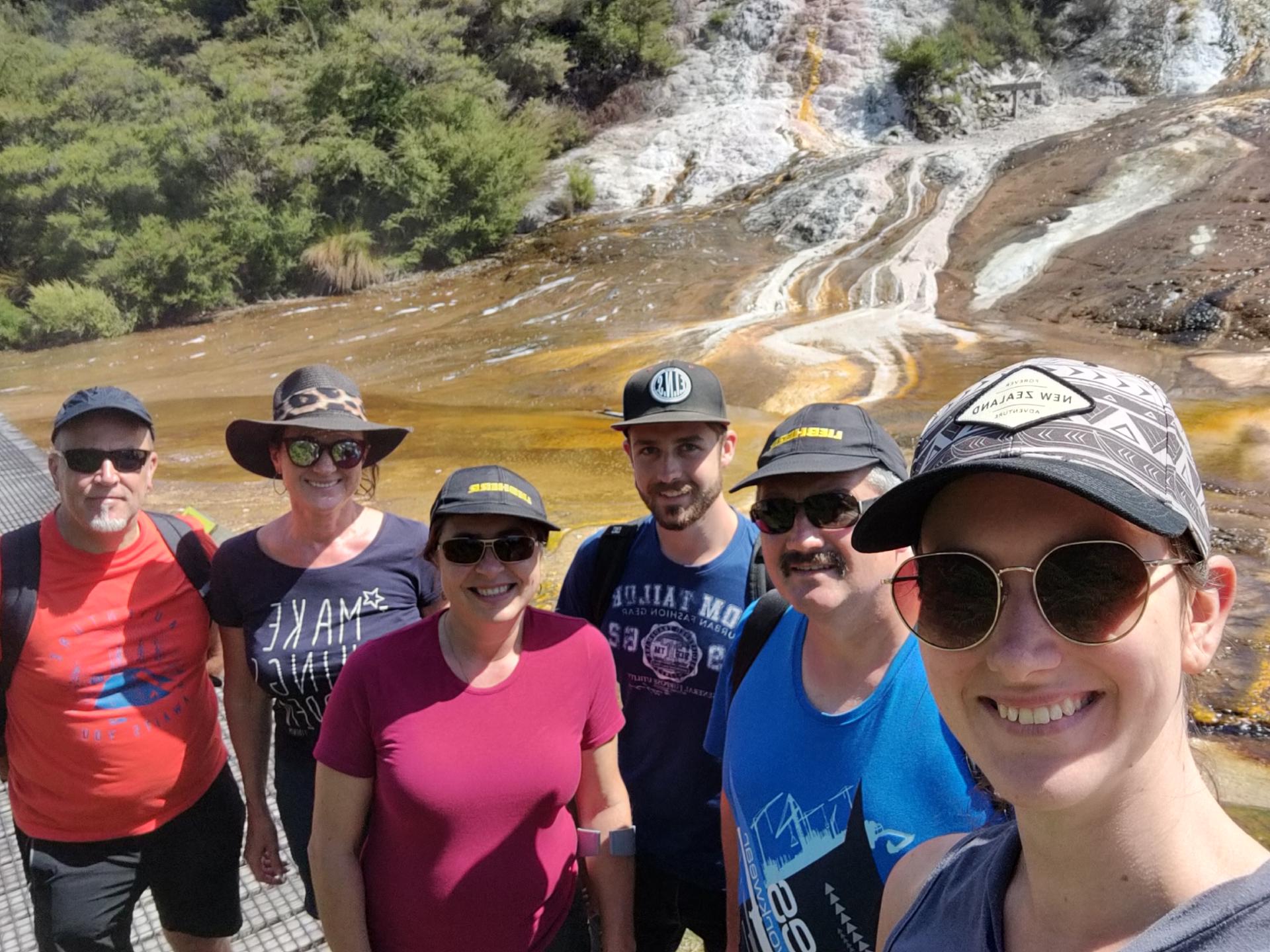
The first sinter terrace you come across on the other side of the river is called Emerald Terrace. The wet surface of the terrace shows an impressive variety of colorful “bubble mats”. These mats are made up of many thousands of tiny microbes that thrive in the warm water flowing over the sinter terrace.
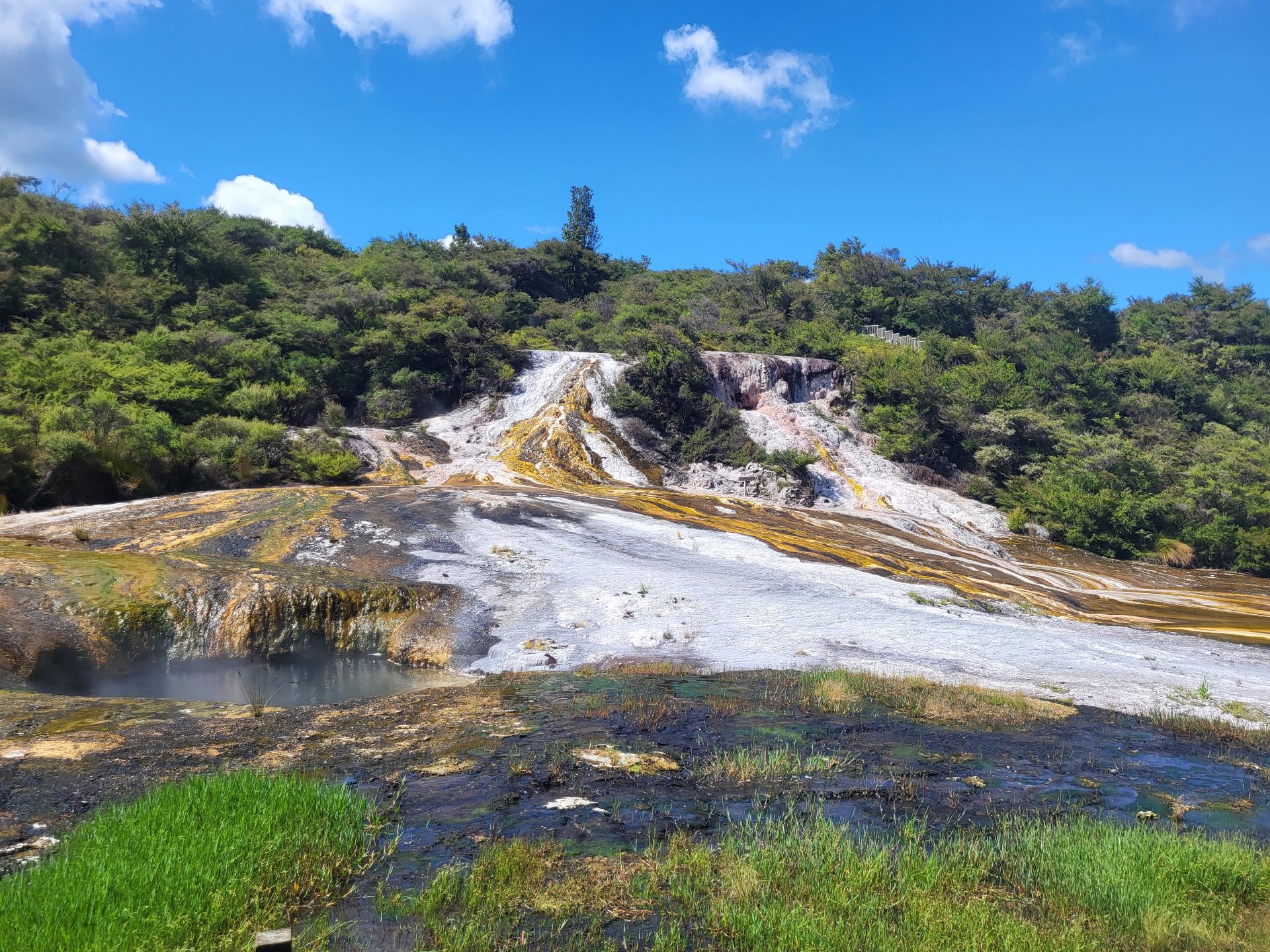
The diamond and sapphire geysers were located on the terrace, but unfortunately we were unable to see their eruptions at the time. The eruptions of the diamond geysers, in which boiling water shoots up to 8 m into the air, are unpredictable and sometimes last only a few minutes, but sometimes many hours. Sometimes the geyser is dormant for a while, while the sapphire geyser bubbles up 5 m away. This geyser is active every 2-3 hours.
A turnoff led to Rainbow Lookout, from where you could see over the entire hot water river, through which almost 20 million liters of water per day run leisurely over Emerald Terrace.

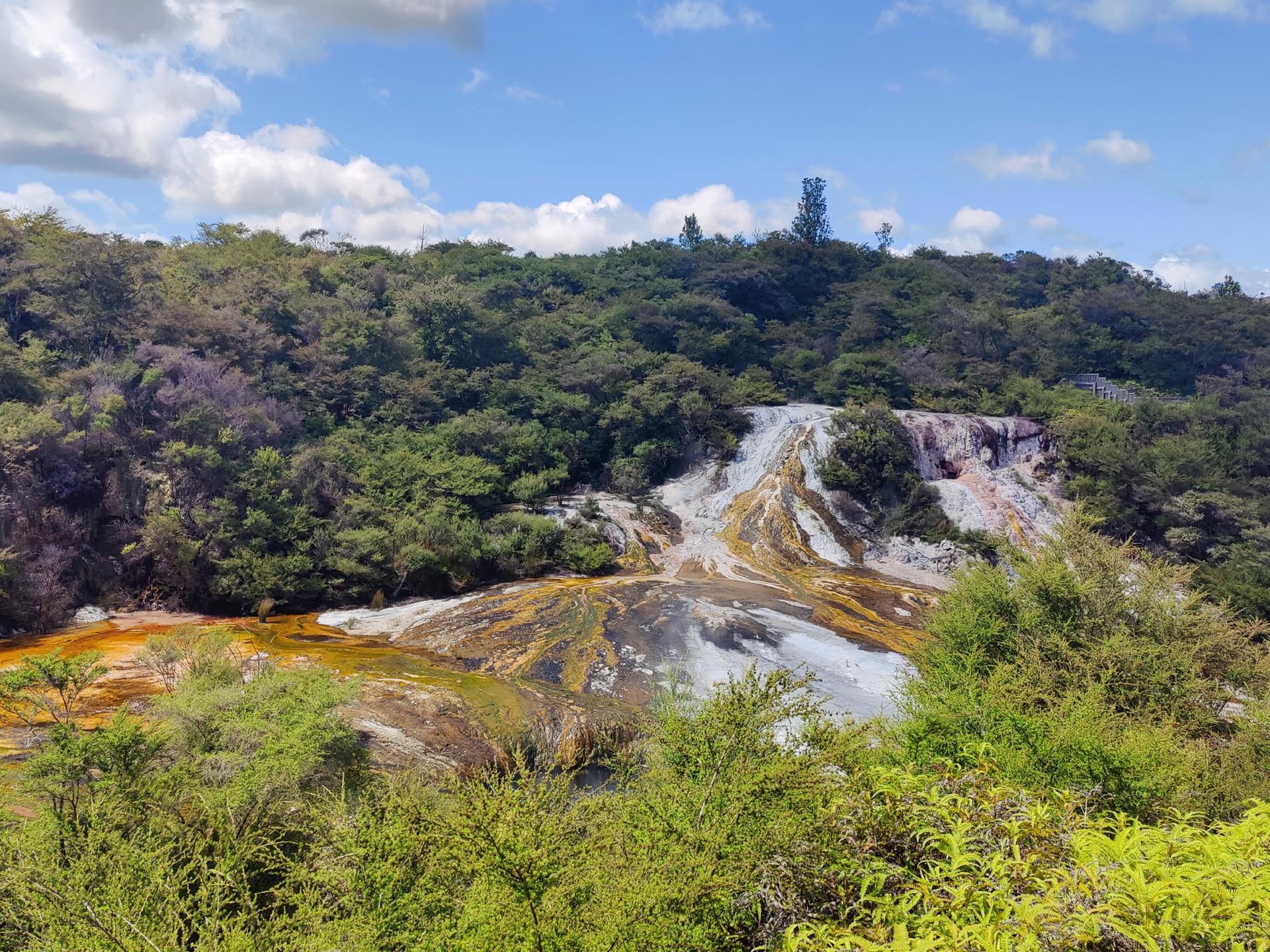
Looking towards the park, we could also see all the fracture steps of the terrace that we would pass later on.

Back on the main path, we passed a hot pool, the Map of Africa. It is about 70 m2 in size and is divided into two basins by a low ridge. The water temperature is between 58-68°C with a pH value of 6.8-7.6. There were two simple indications that the water in this basin is fed exclusively from thermal springs upstream of the basin and not from springs within the basin: There is no obvious upwelling of spring water and the inflow into the basin is roughly equal to the outflow from the basin, which also suggests that the basin is probably not fed by an independent spring within the basin. At the outflow point, the water flows quickly. Where the flow velocity is higher, the green bubble mats expand and lengthen as a result of the increased flow.
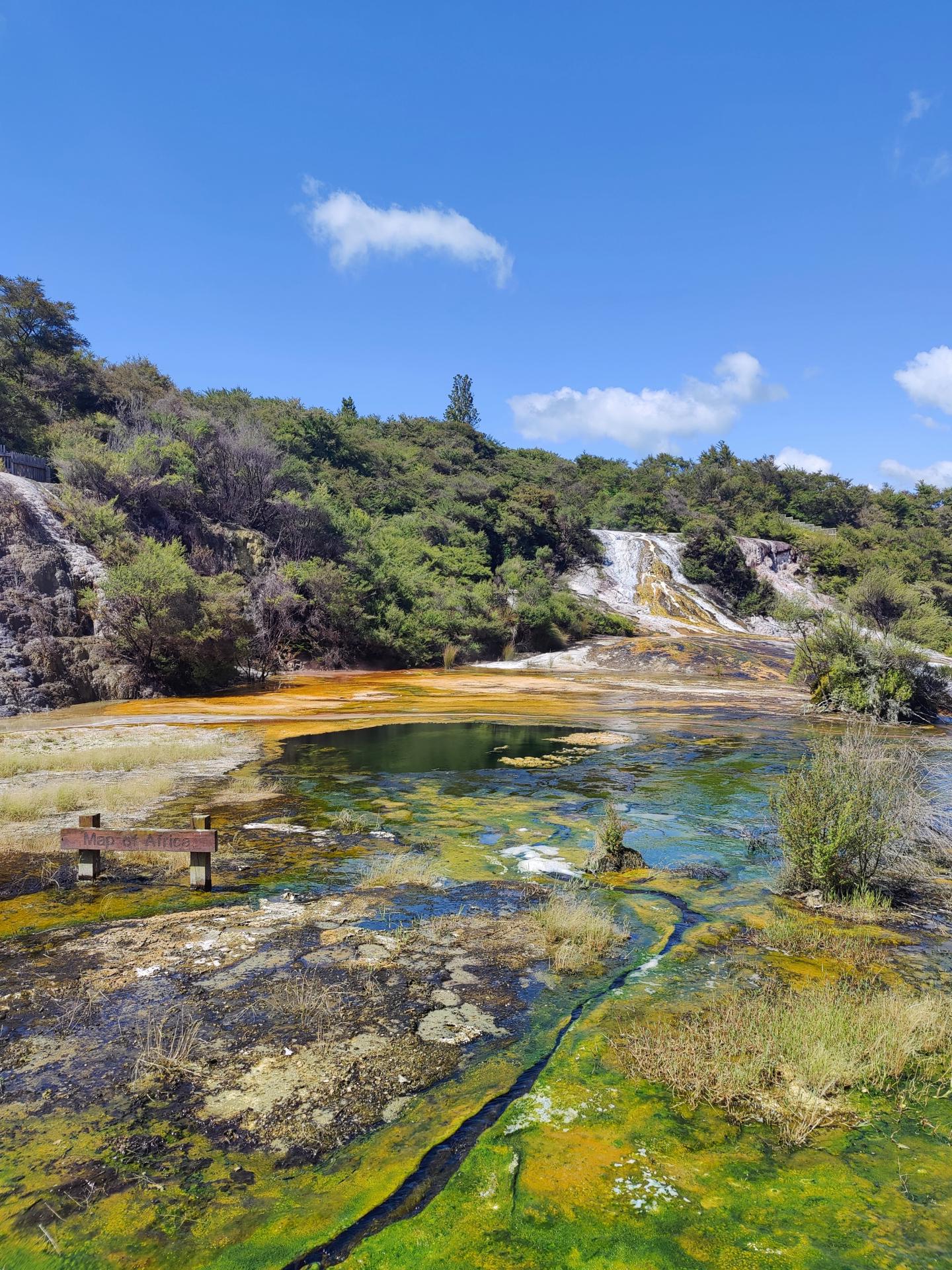
The Rainbow Terrace was adorned with incredible colors created by the hot water algae that grow here in water temperatures of up to 60°C.

Water flows onto Rainbow Terrace from a steam vent called Devil’s Throat. The name could come from its steaming appearance as well as the sounds it made.
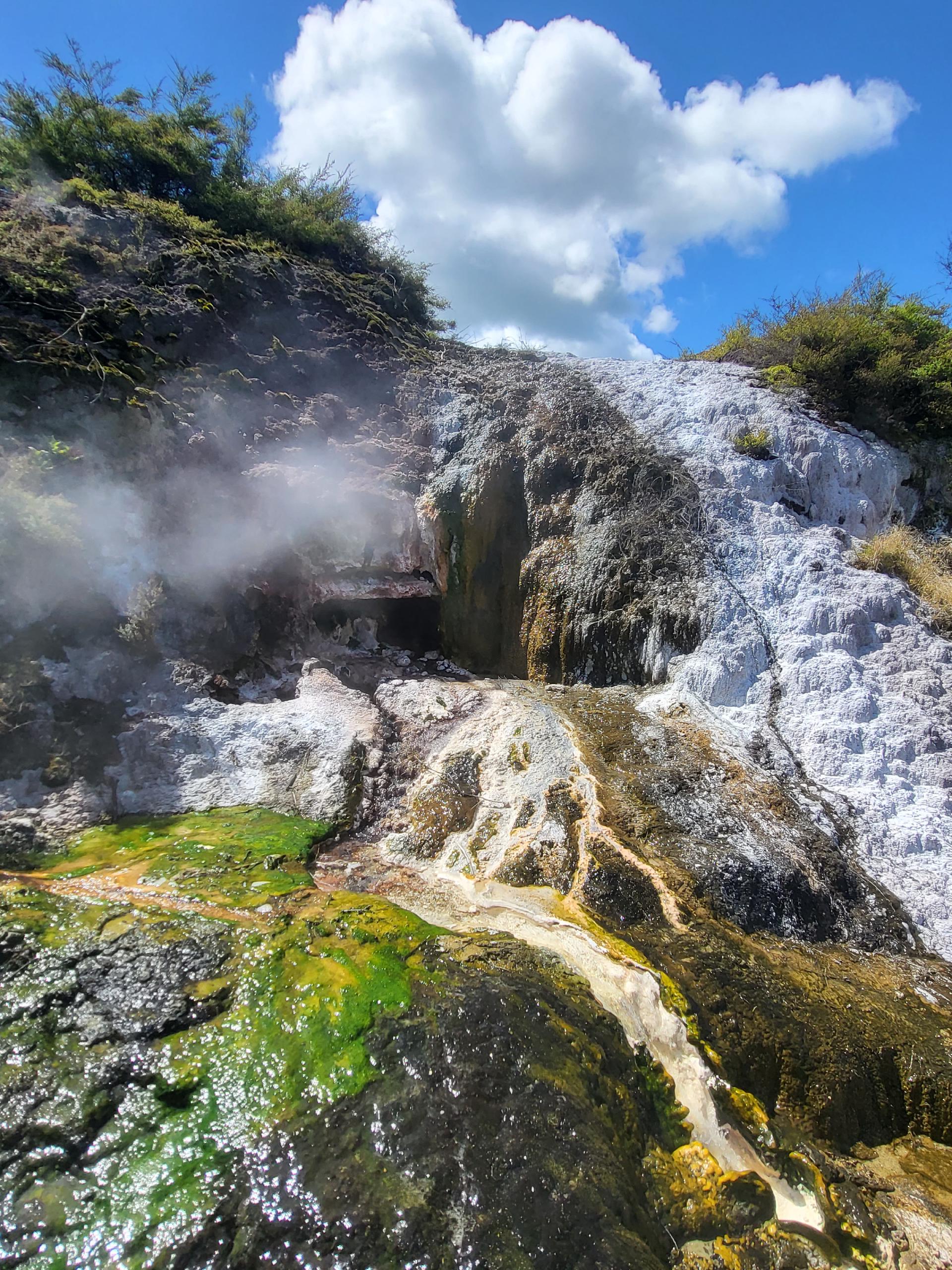
The water had carved its own path there, like a small river through the geothermal landscape.
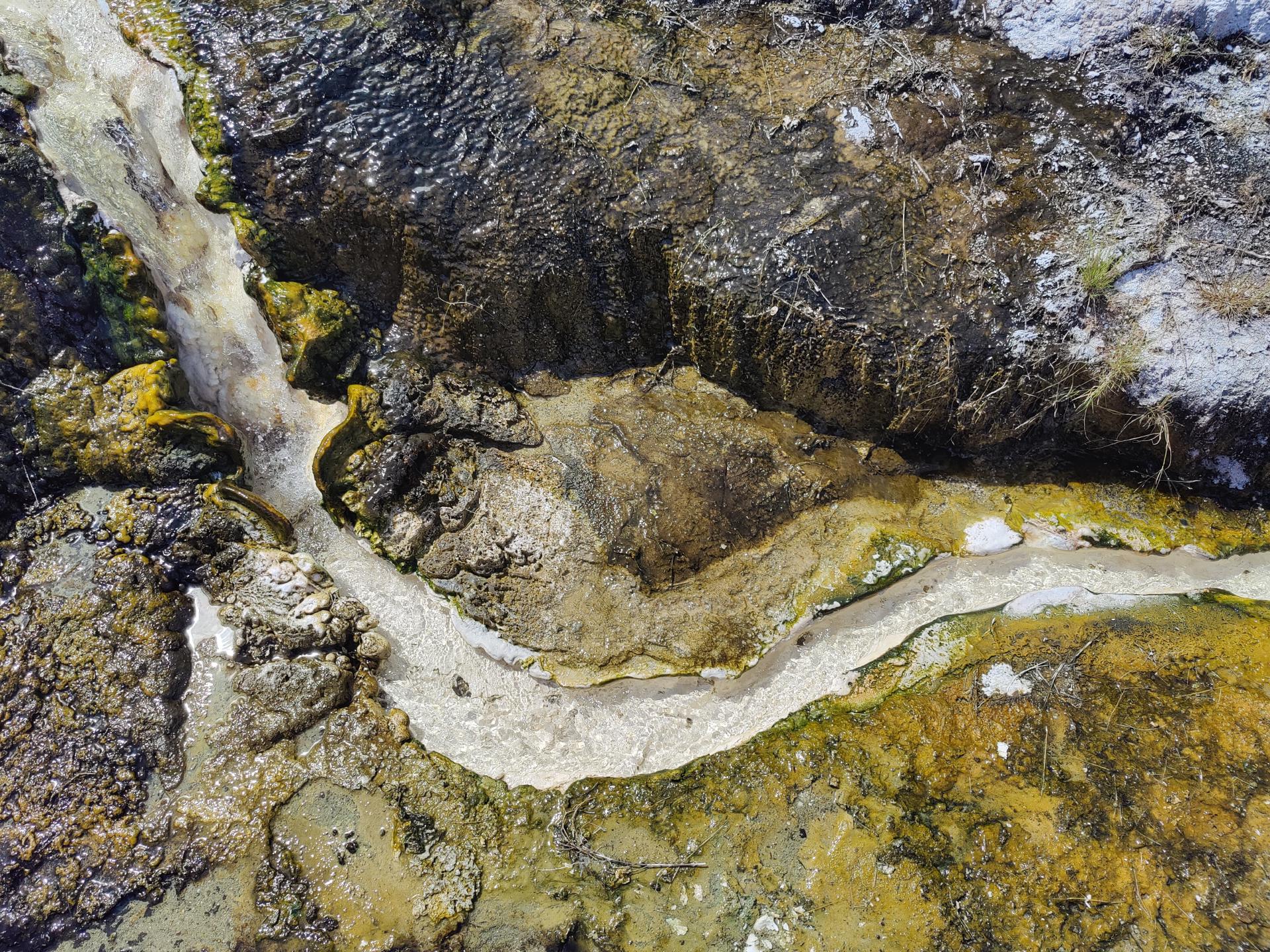
One of the three large fracture steps was formed during a major earthquake in 131 AD, around the time when the world’s largest known volcano - Lake Taupō - last erupted.

At the foot are several small geysers and the large Hochstetter’s Pool, named after the Austrian geologist who worked here in 1859 and described the thermal activity. Hochstetter’s Pool is a 5 m long, round pool with vertical sides, whose water drains onto the Rainbow Terrace. The pool is surrounded by yellow, orange and green microbial mats.

Despite all the rain over the last few days, the pool at that time had absolutely no water and was more or less just a big hole in the terrace.
The 5 m high and 40 m long Golden Fleece Terrace is called Te Kapua (the cloud) by the Māori.
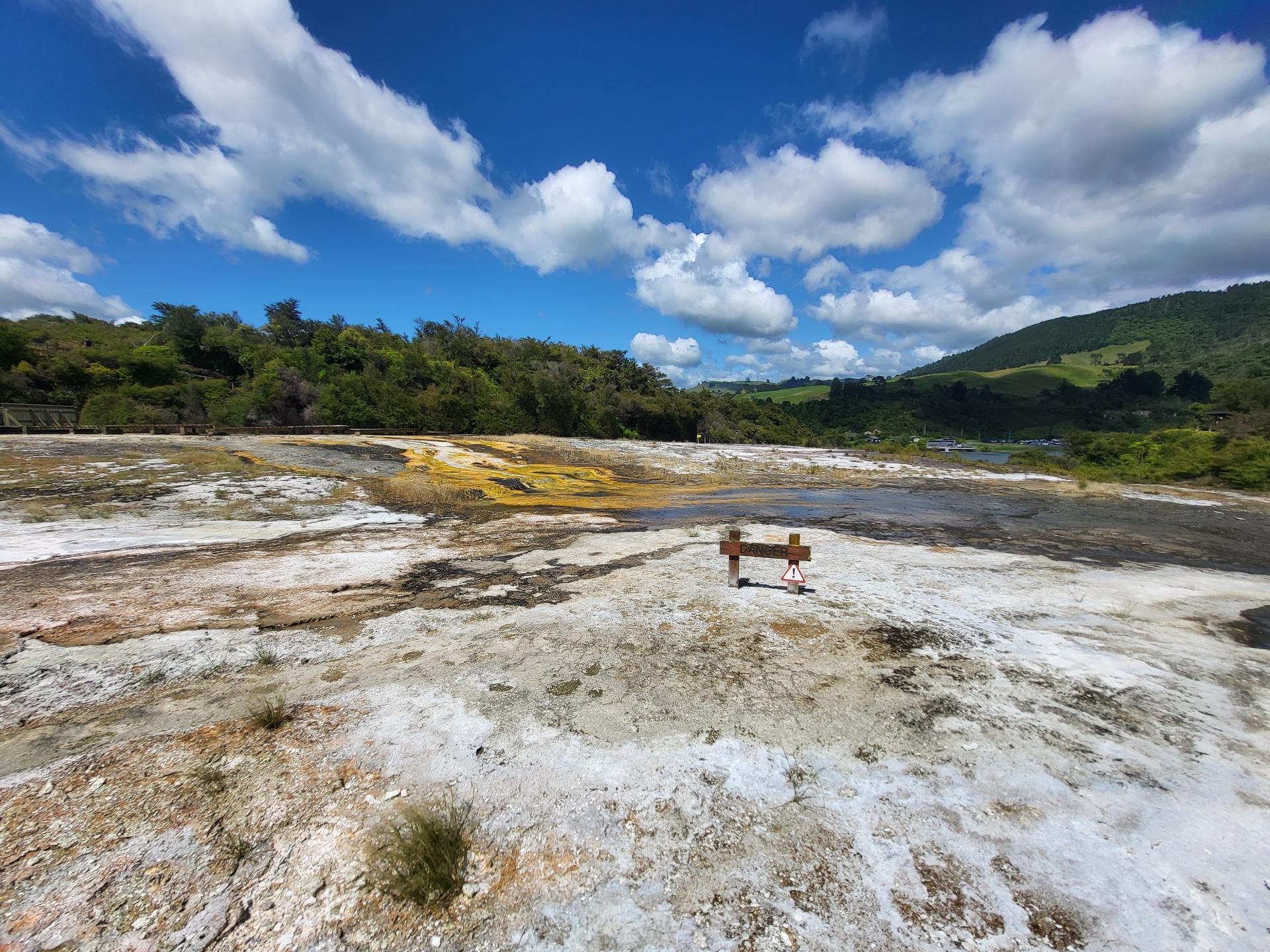

It is the third fracture step created in 131 AD.
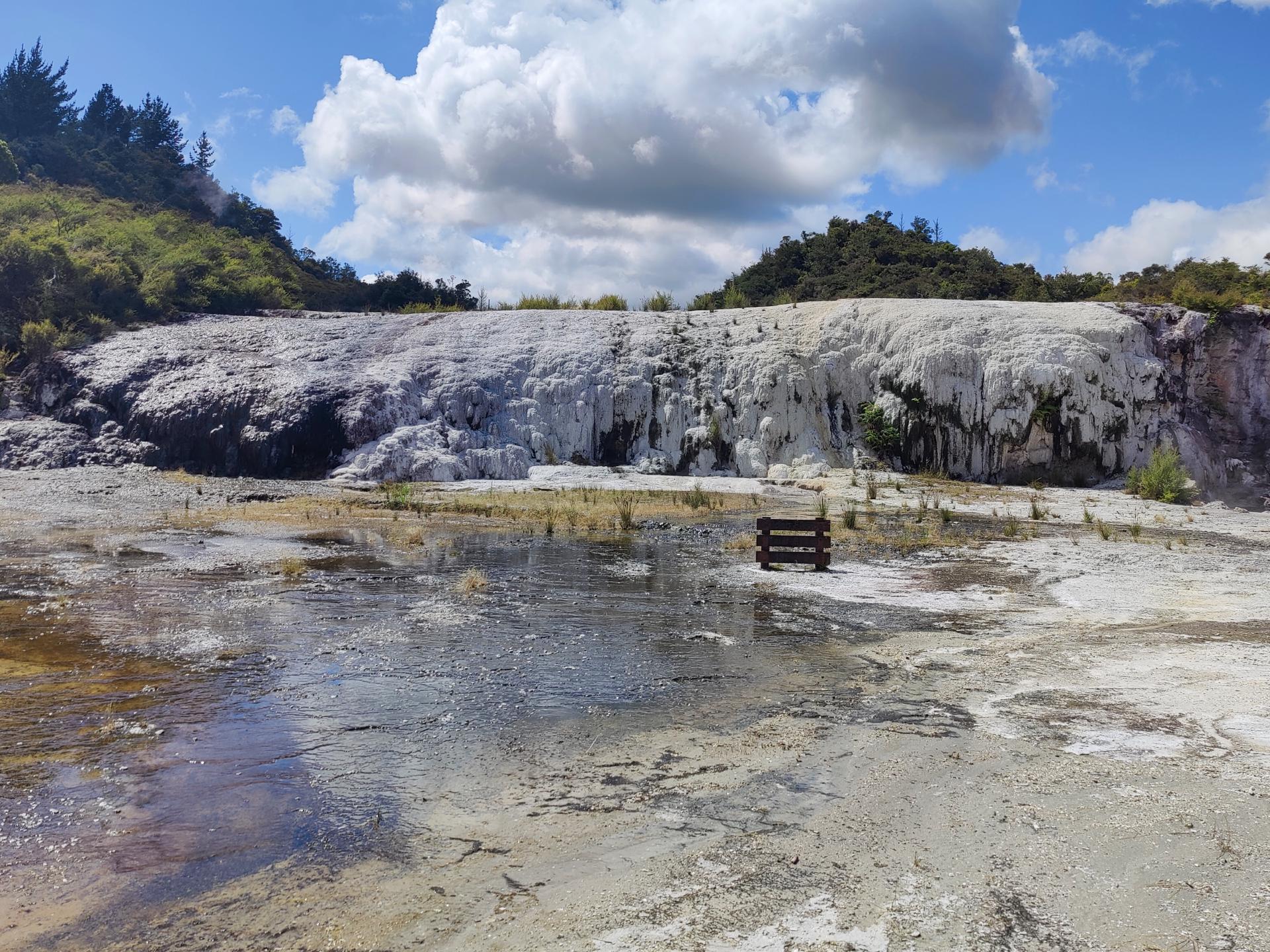
Geysers often bubble up right at the corner and due to its extreme unpredictability, this area must not be entered.

On the Golden Fleece Terrace there is plenty of old silicified plant material, which is easily recognizable in the sinter. In the past, reed-like grasses grew on this terrace. When the grasses died, they were enveloped by the silicate layer and fossilized in the sinter. New microbial communities are currently colonizing the Golden Fleece Terrace. These colorful microbial mats began to grow in early September 2001 when water began to flow over this part of the terrace again, creating favorable conditions for microbial communities.
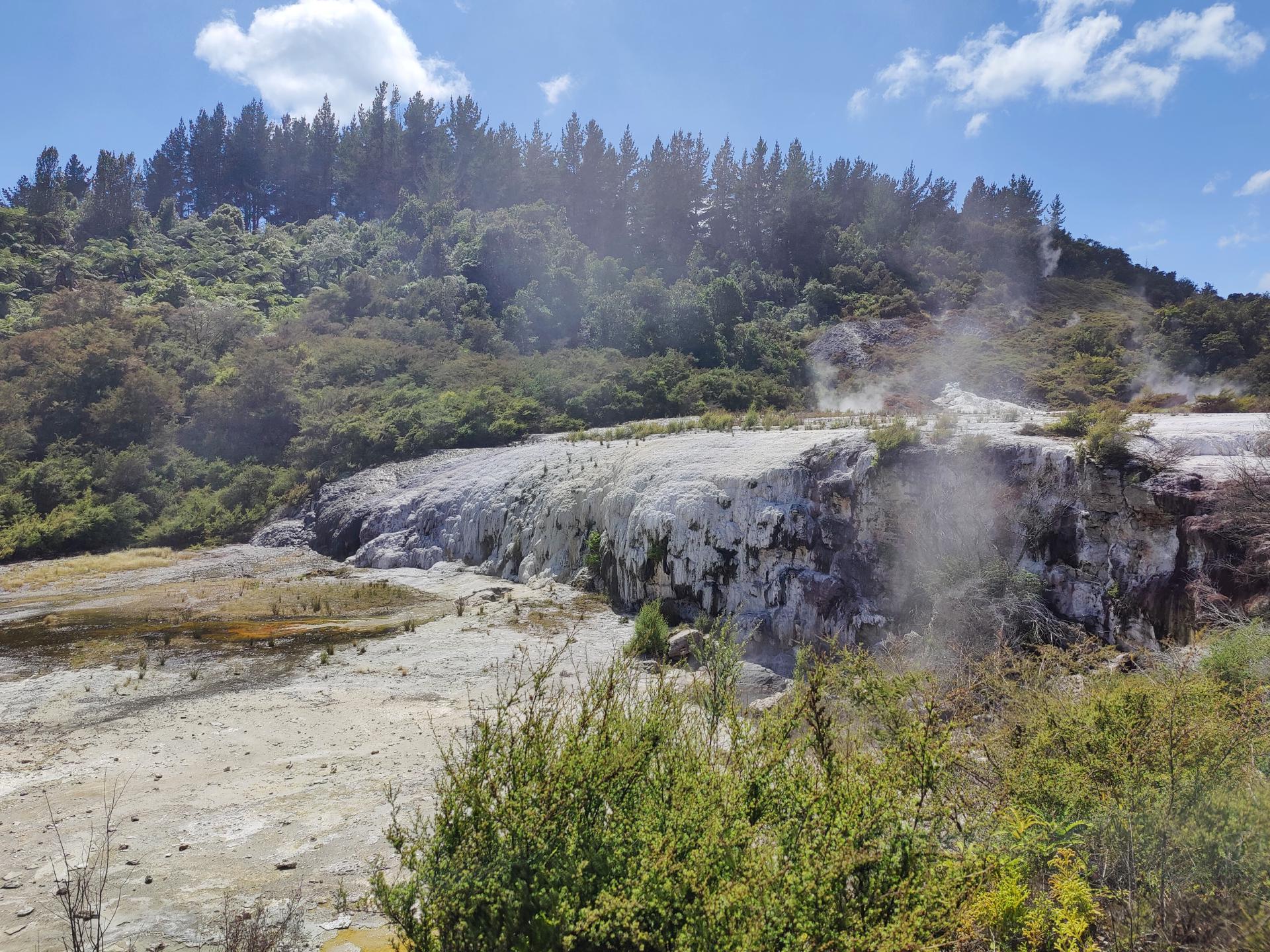
Parallel to the fracture step, the path led upwards, past an elephant-like looking rock.
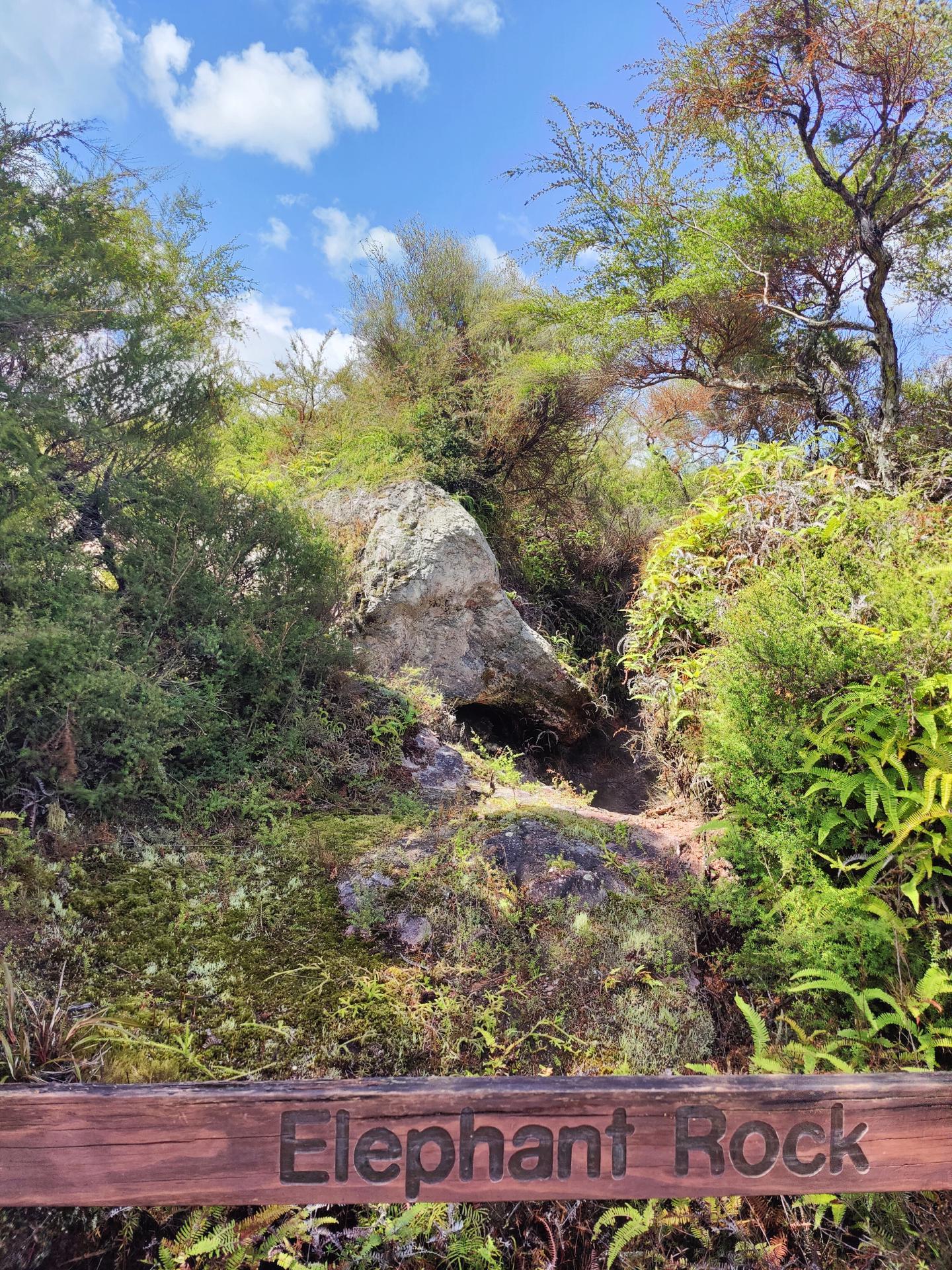
Kei Runga Ite Mania / The Artist’s Palette is an almost flat, 10,000 m2 silicate sinter terrace. The quartz sinter on Artist’s Palette fills an ancient hydrothermal eruption crater that formed 8,000 to 14,000 years ago and is still particularly dangerous and unpredictable today. Remnants of the hydrothermal crater wall form steep steaming ridges. In some places, the silicon blanket is only 20 mm thin. Today, the white silicate sinter terrace is about 150 m long and varies in width between 35-115 m.
Clear blue alkali chloride water forms pools, springs and geysers. These pools occur at or below the water table. Steaming soils are also a surface runoff feature on this terrace. The visible steaming soil is above the water table. The activity is so variable that the springs sometimes emit large quantities of hot water, which flows over the silicon surface and creates ideal conditions for algae growth. The many different shades of brown, green, yellow, orange and pink, interspersed with numerous crystal-clear blue waterholes, give this remarkable region an unimaginable charm that is aptly described by the image of an artist’s palette.
The amount of water flowing from the springs onto the sinter terrace fluctuates constantly. At times the water level is below the top of the terrace, while at other times a large part of the sinter terrace is covered by a shallow stream of hot alkali chloride water. Currently, the water level was relatively low, which meant that Hochstetter’s Pool had no visible water and the variety of colors was limited.
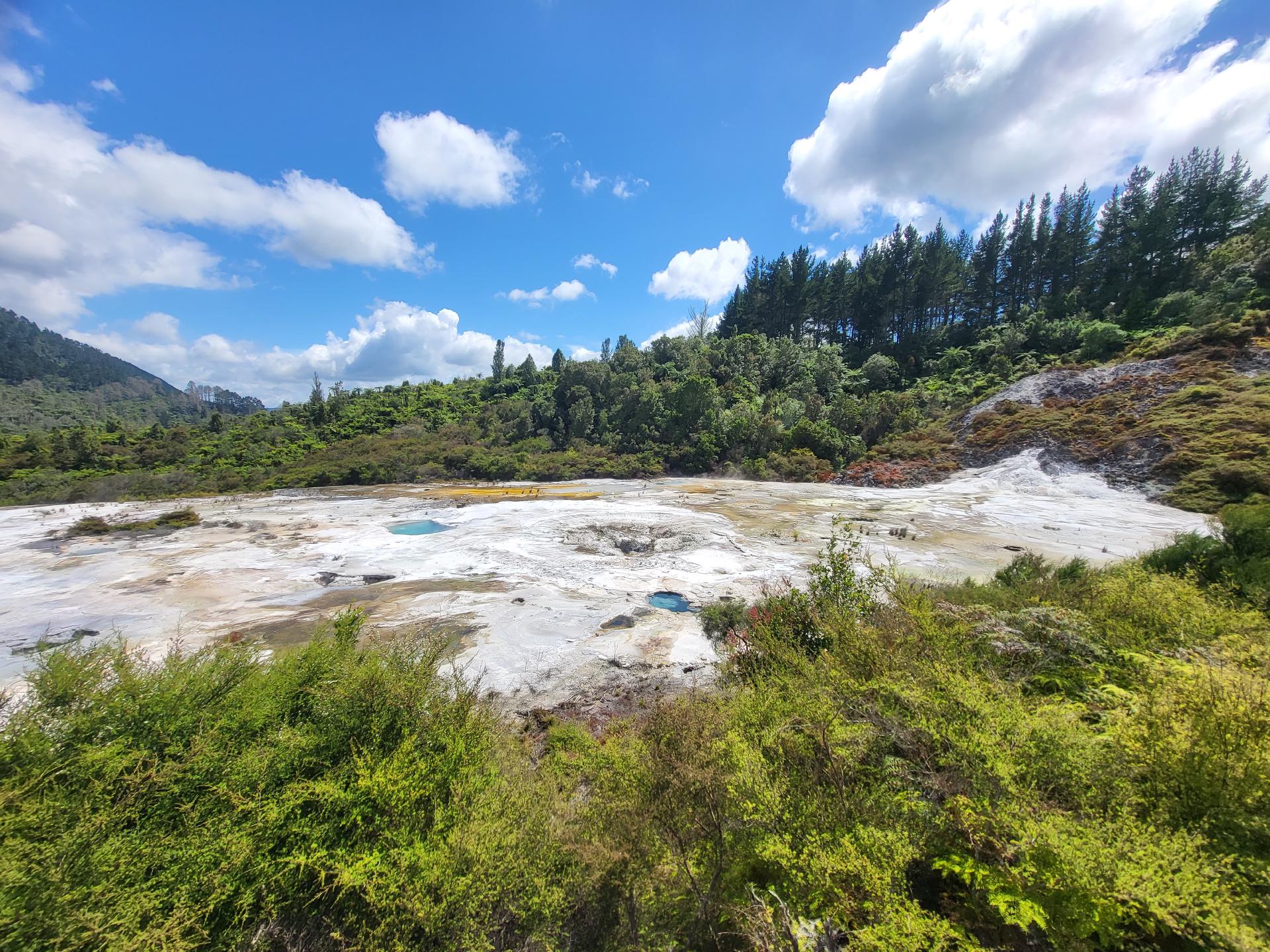
The Ruatapu Cave - sacred cave - drops steeply into volcanic tuff. Tuff is solidified ash that was deposited during a volcanic eruption. This eruption took place around 100,000 years ago. The cave is one of only two known caves in the world located in a geothermal area. The other is located in southern Italy.
The cave extends 45 m into the surrounding rock and drops 23 m. The small pool at the foot of the cave is known as Waiwhakaata or The Pool of Mirrors. The water of Waiwhakaata Pool is an acidic mixture of sulphate-chlorides with a pH value between 2.1-3.0 and a water temperature of around 44°C. Steam and hydrogen sulphide gas (H2S) rise from the surface of the pool. The H2S dissolves in the steam. When the steam cools and condenses, an acidic condensate forms, which reacts with the tuff and produces the alteration minerals visible on the walls above the basin.

There are two theories about the origin of Ruatapu Cave. One of them says that the cave is a hydrothermal eruption crater in which the heat and vapor pressure under the tuff became so great that it erupted and formed the cave. During a hydrothermal eruption, numerous rocks are thrown out of the cave and deposited around the cave opening. These rocks are known as hydrothermal eruption breccias. However, no hydrothermal eruption breccias were found at the mouth of Ruatapu Cave.
The other way in which the cave could have been formed is by dissolution along rock fractures. When a huge fumarole produces acidic condensate, the acidic condensate eats into the overlying tuff along rock fractures and dissolves it. The tuff then collapses and forms a cave. As rock changes can be seen directly above the acid basin, it is likely that this cave is a dissolution crater.
By now we were a lot higher up and had a view over the entire park and the complete Artist’s Palette. It was a very fascinating sight to see the geothermal activity taking place in the middle of the green forest.
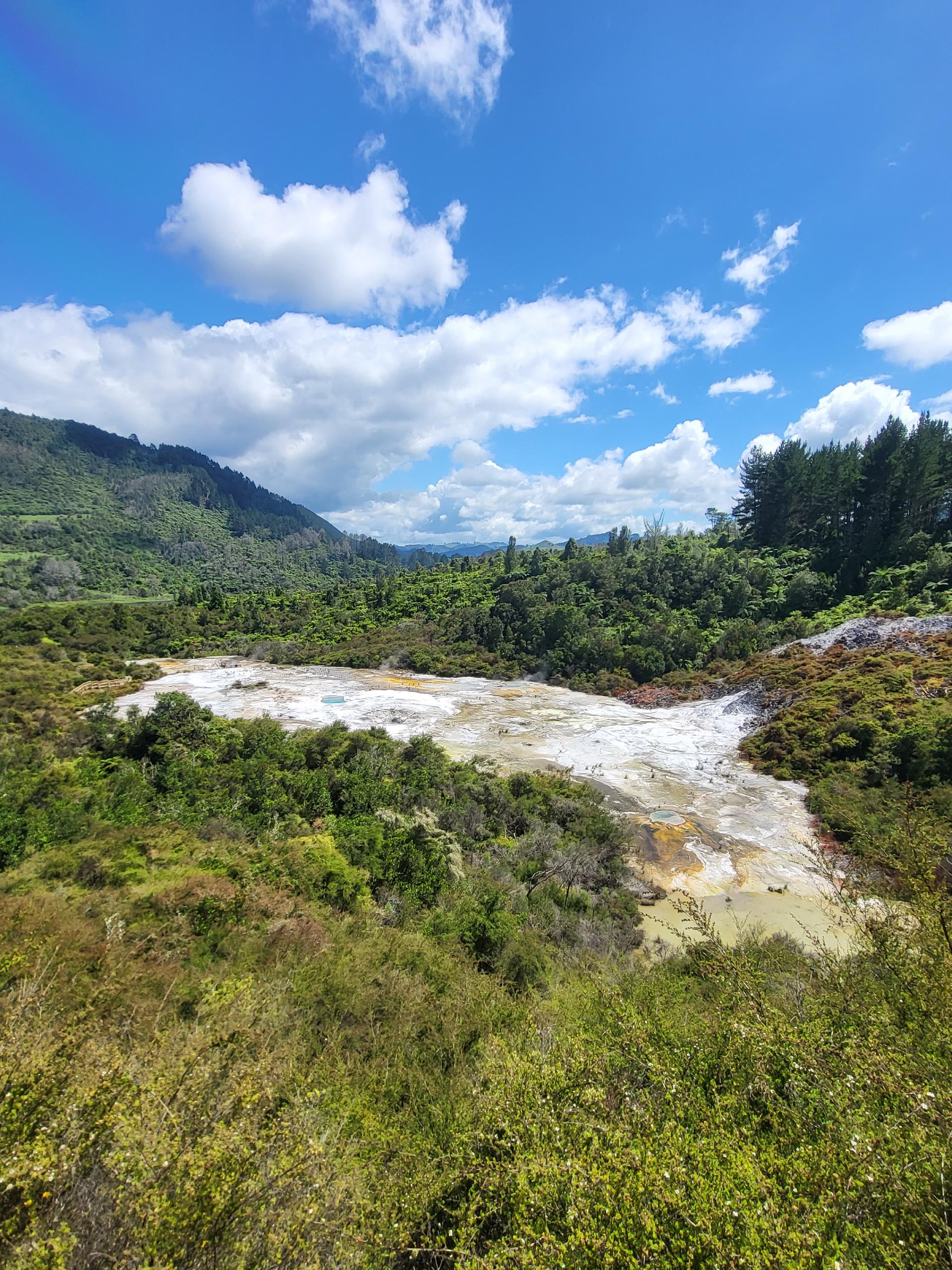
On the way to the next stop (the Mud Pools) we already passed a kind of chalk cliff, the consistency of which was very strange - probably due to the proximity to the pools. The path led through beautiful scrub vegetation to the boiling mud pools.
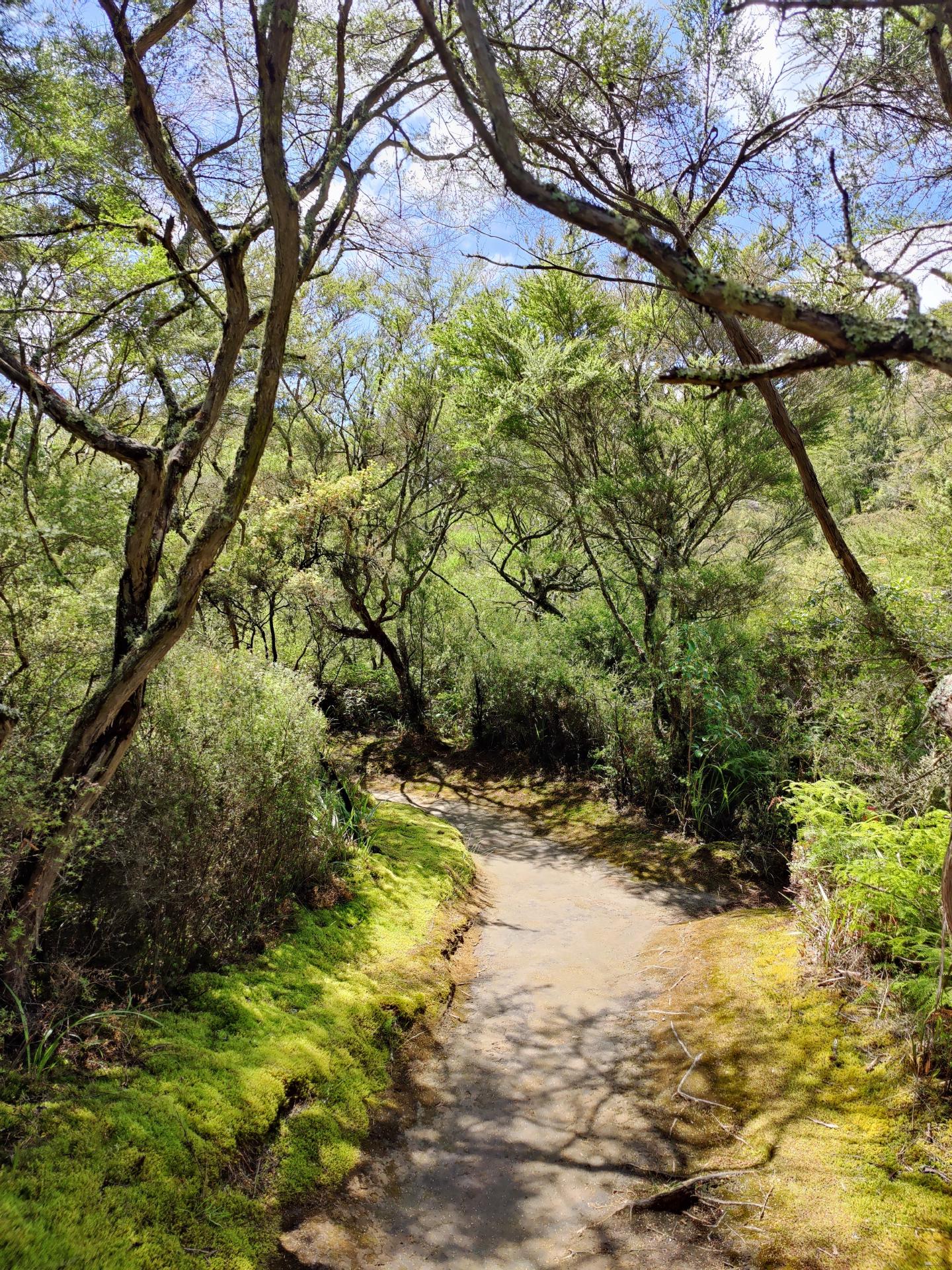
Along the way, we saw beautiful New Zealand tree ferns (pongas), and also the silver ferns, a New Zealand national symbol with a silvery sheen on the underside of the fern leaf.
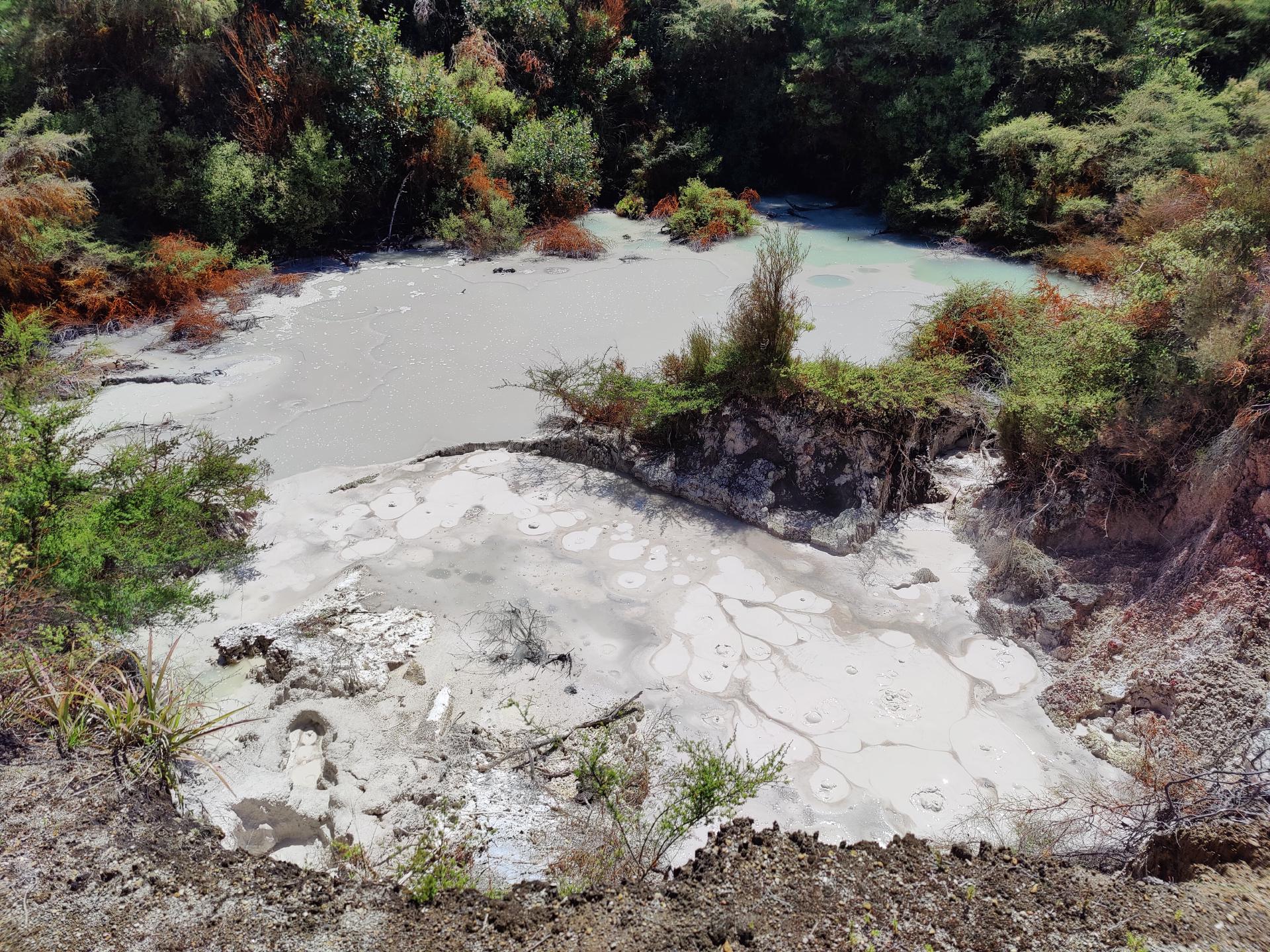
Mud holes form where the hot mineral water has dissolved the rocks lying on the earth’s surface and formed clay. The clay is heated by the ground heat and boiling mud holes are formed.
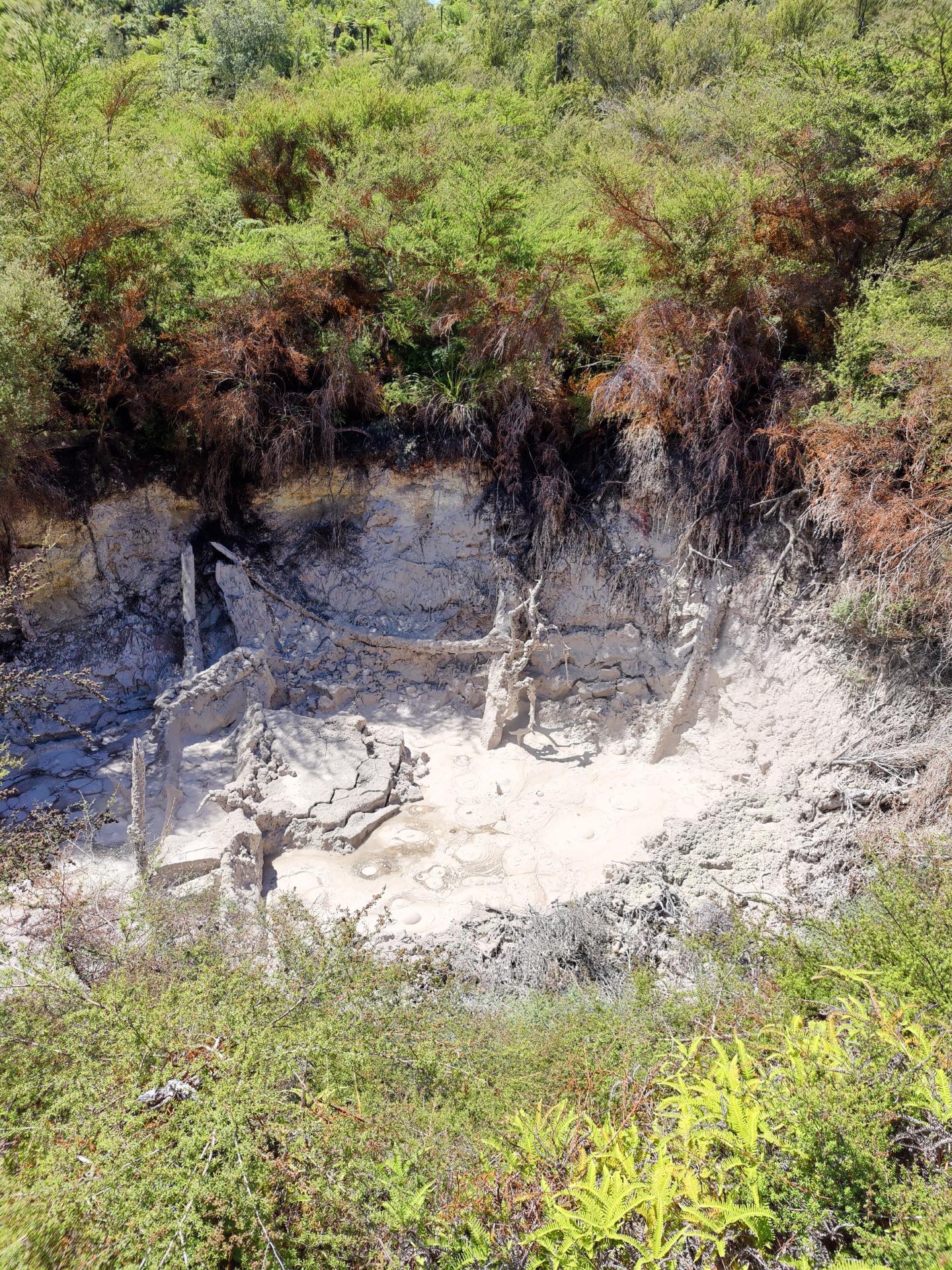
Activity varies depending on the time of year and is dependent on the amount of rainfall, which determines whether the mud is drier or more watery. This is why the mud pools appear more active in winter than in summer. Nevertheless, they were probably the most beautiful and active mud pools we had seen.
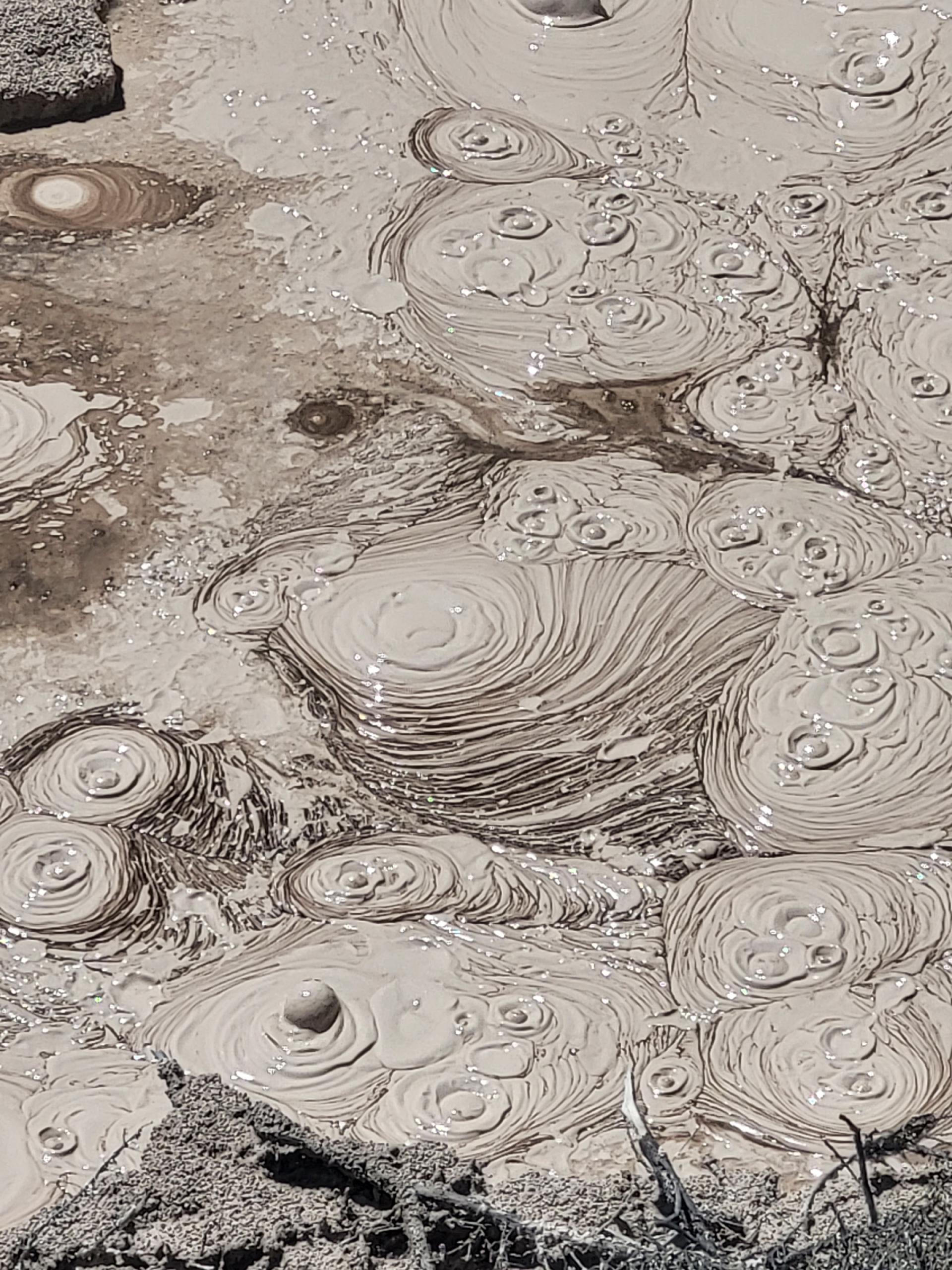
On the way back to the jetty, we first walked through the forest, which had surprisingly soft, elastic ground. We wondered whether this was also due to the clay.
The geysers on the sinter terrace erupt at irregular intervals and we suspected from a distance that we could hear a louder bubbling than before. And so it was - a small geyser, which had previously just been a quiet waterhole, was erupting.
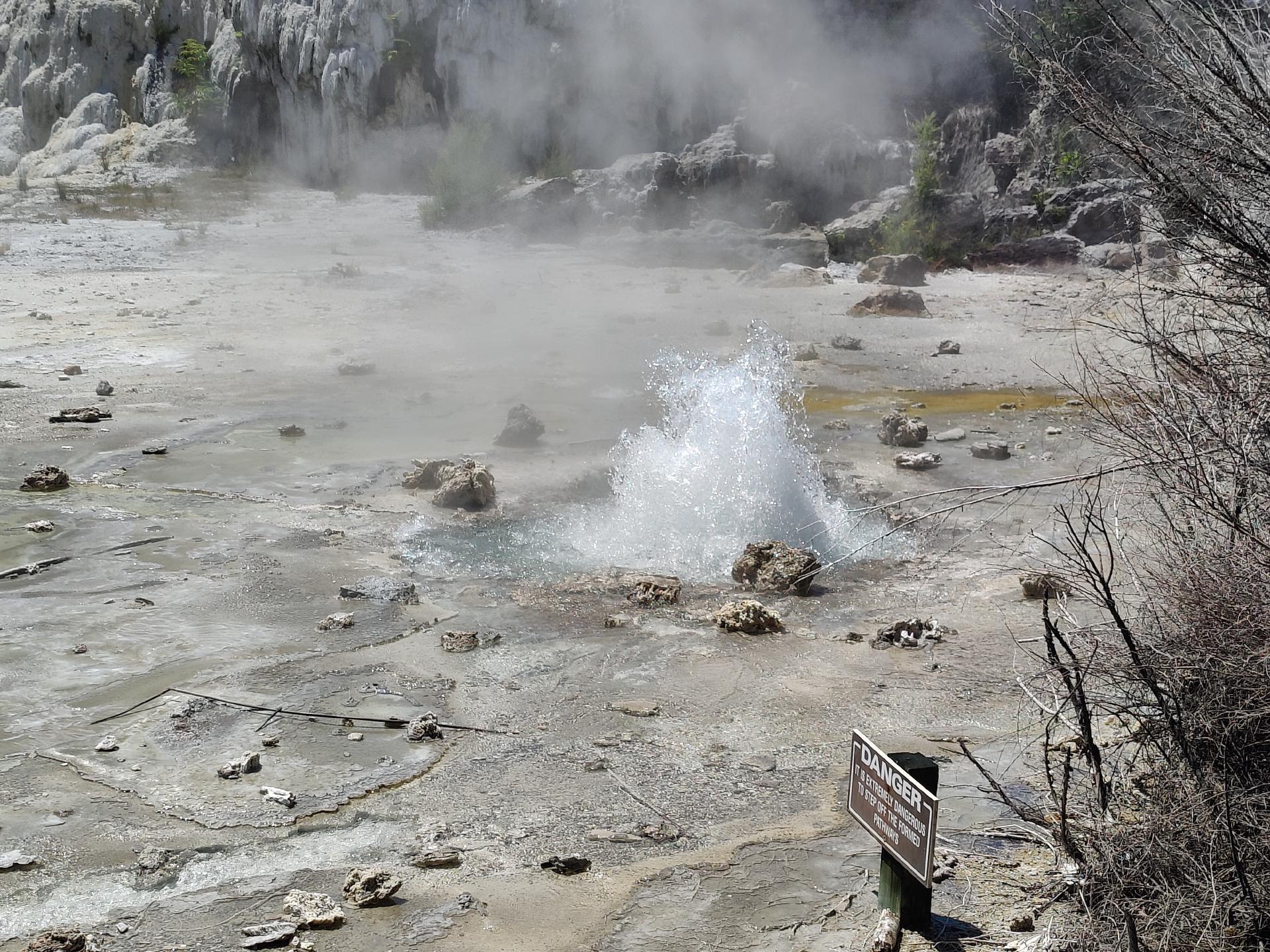
The path continued along the sinter terrace again before branching off into the forest once more.
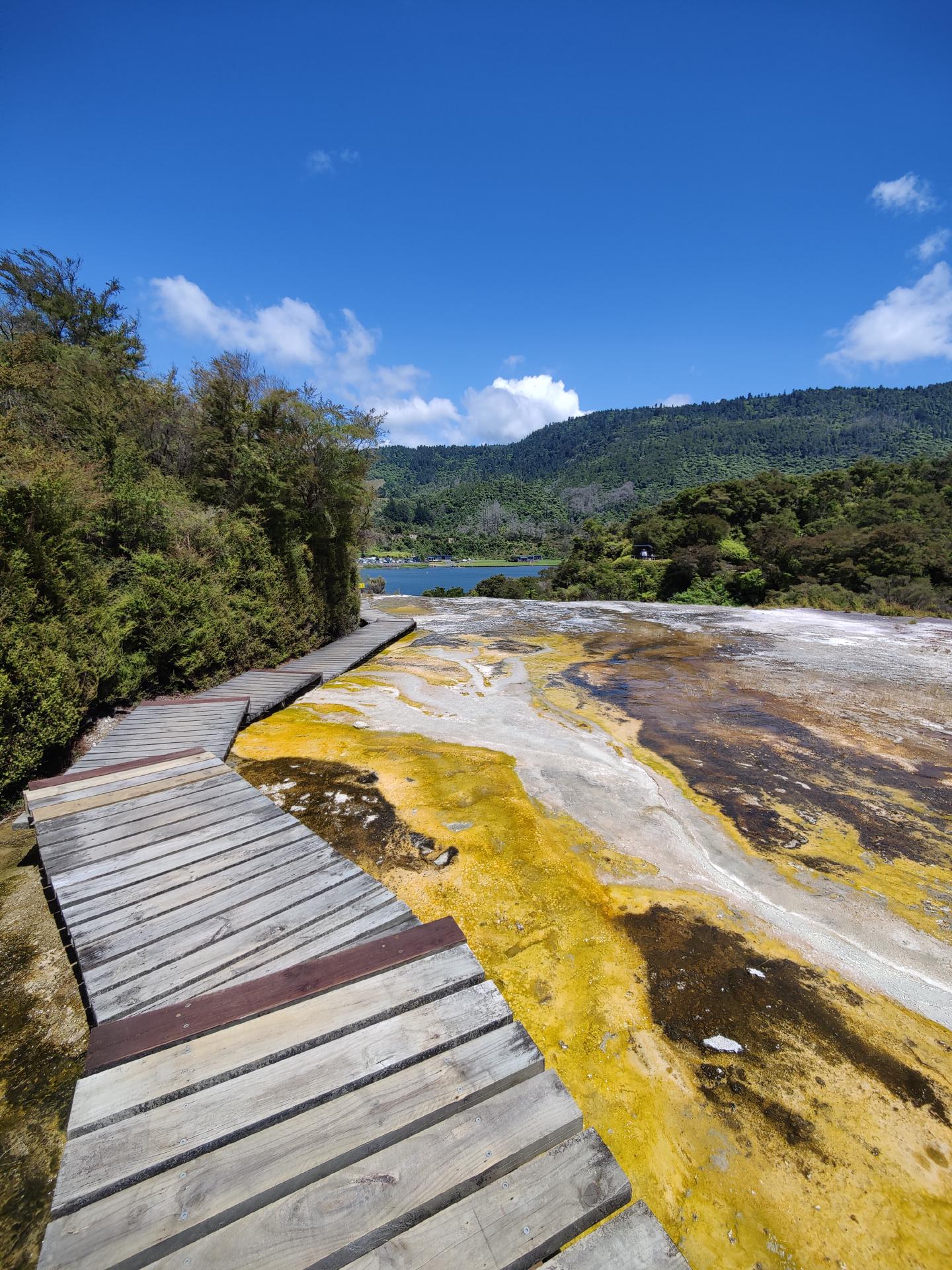
After a dormant period of 17 years, the Waiariki soda spring suddenly came back to life in 1984. Since then it has been very unpredictable, filling up and gushing forth at will.

From up there you could take another look at Rainbow Terrace with the countless palm trees and ferns in the background.

Then we headed back down the steps.
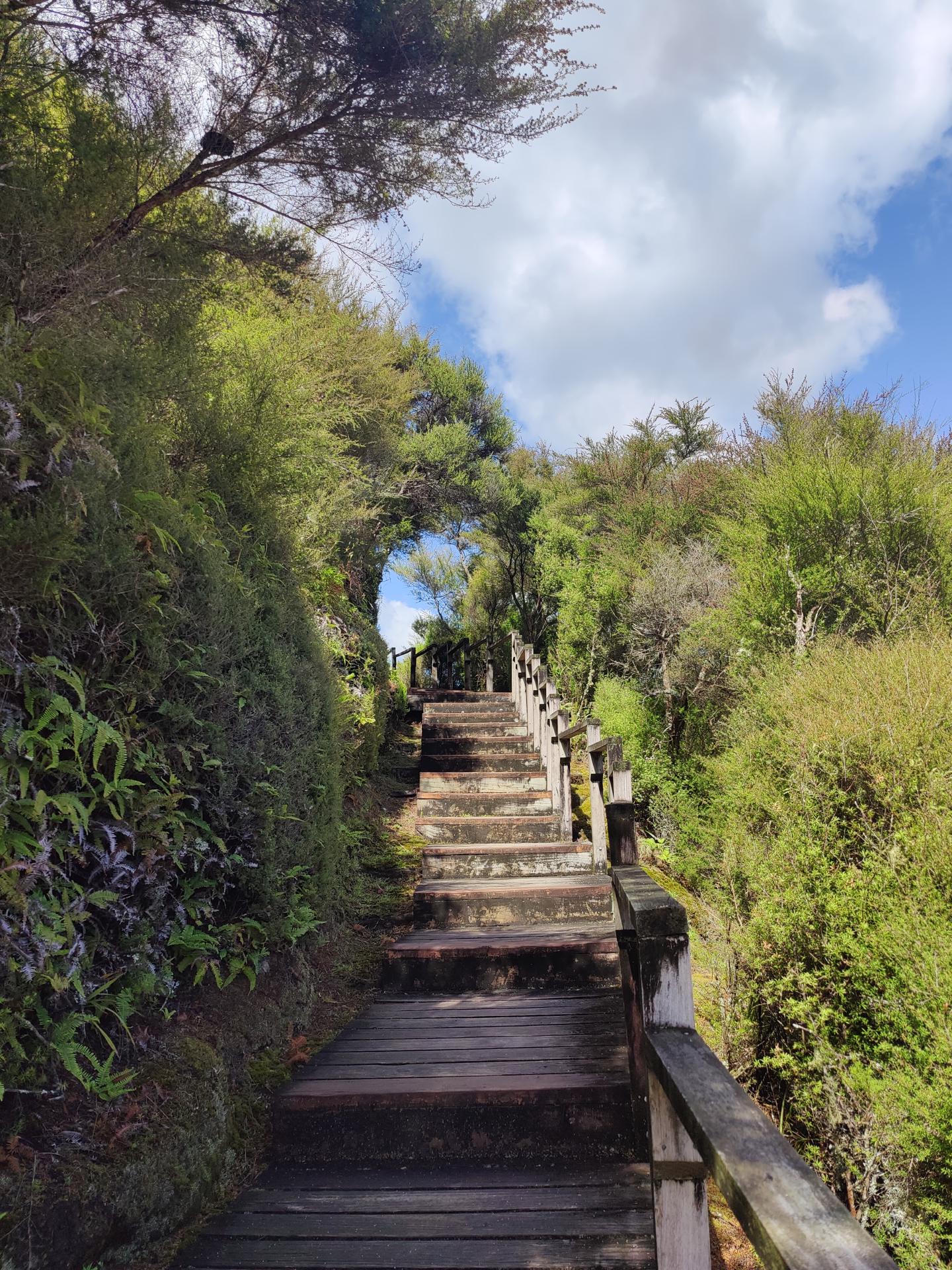
From a distance, we heard another roar and noticed that one of the diamond geysers at Emerald Terrace was now erupting as well. The bubbling was not particularly high, but you could still see very clearly where the geyser got its name from: the water fountain erupted in millions of droplets that sparkled like diamonds in the sun.
Today’s circular walk was only about 2.5 km long, but it was certainly one of the most beautiful geothermal parks we had visited. At the foot of the terraces, we waited for the boat that would take us back to the parking lot. This silicate terrace - often mistaken for a solidified lava flow - is between 20 mm and 20 m thick in places and extends a further 35 m below the lake surface.
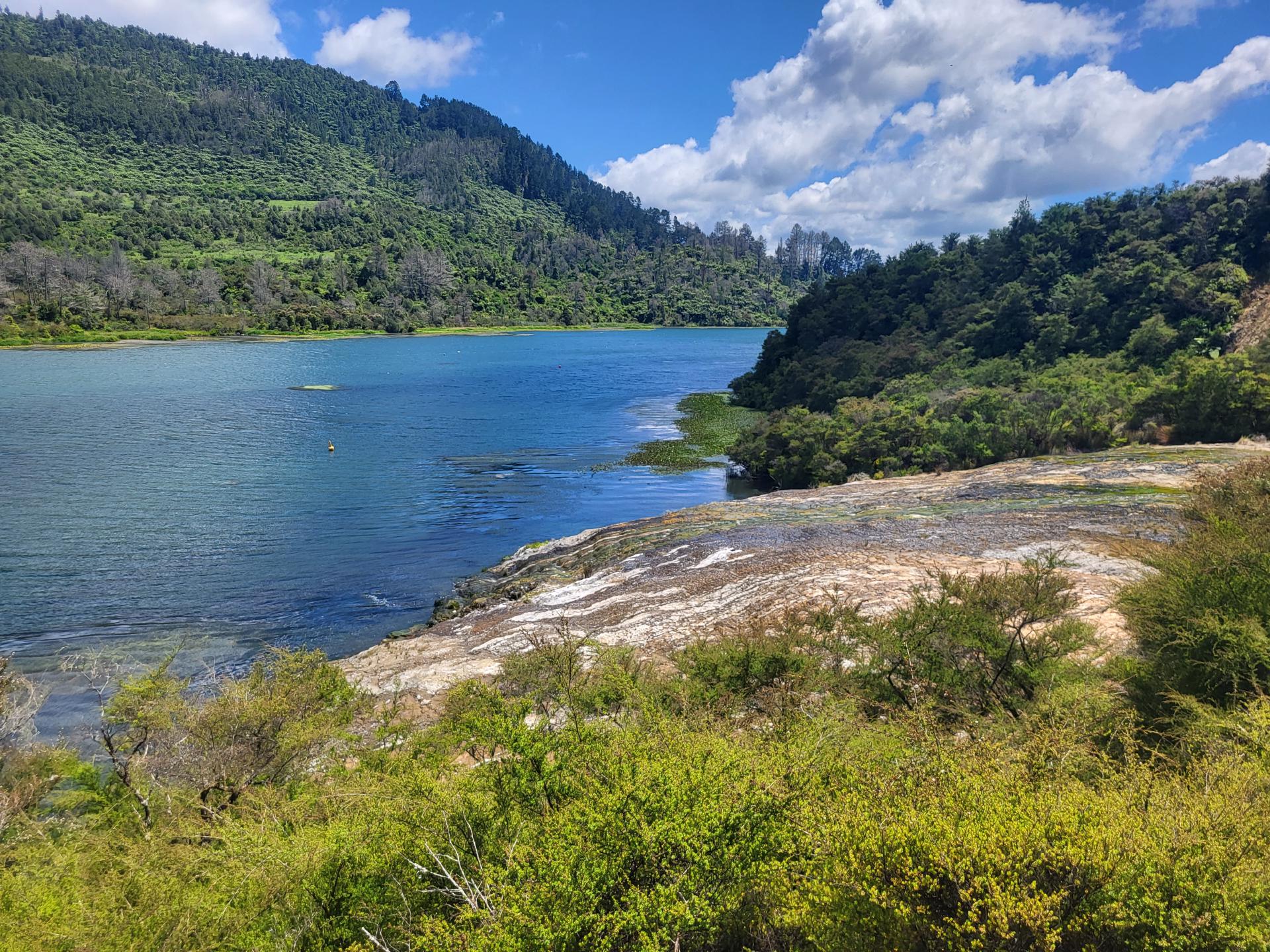
This concluded our morning activity and we made our way to Taupō, where we would spend the rest of the day before parting ways again…

